The Economics and Statistics Division maintains archives of previous publications for accountability purposes, but makes no updates to keep these documents current with the latest data revisions from Statistics Canada. As a result, information in older documents may not be accurate. Please exercise caution when referring to older documents. For the latest information and historical data, please contact the individual listed to the right.
<--- Return to Archive
For additional information relating to this article, please contact:
December 15, 2021ANALYSIS OF NOVA SCOTIA'S CONSUMER PRICE INDEX FOR NOVEMBER 2021 TRENDS – November 2021
Nova Scotia’s All-Items Consumer Price Index (CPI) increased 5.3% year-over-year in November 2021, ticking downward from the 5.4% year-over-year increase in October. Nationally, consumer prices were up 4.7% from a year earlier, unchanged from the 4.7% increase in October 2021.
The increase at the national level was the fastest pace since February 2003. Statistics Canada noted that the national prices increase were attributable to supply chain disruptions putting upward pressure on durable goods like passenger vehicles and furniture. Higher prices for gasoline (+43.6%), furniture (+8.7%) and food (+4.4% )were main contributors. Excluding gasoline, the CPI was up 3.6% compared to November 2020. Prices for goods (+6.9%) rose faster in November than October while prices for services (+2.9%) grew at a slower pace. Declining prices for cellular services (-17.9%) contributed to slowdown in service prices.
Food purchased from stores rose 4.7%, the largest increase since January 2015. Fresh vegetable prices were up 2.3% on higher shipping costs and supply chain disruptions. Fresh or frozen beef prices increased 15.4% with poor crop yields making feed more expensive.
Impact of COVID-19 on the Consumer Price Index
Statistics Canada removed all special treatments for goods and services that were unavailable from the CPI measures in November 2021. Cruise-based travel tours is no longer imputed but adjusted based on comparing November 2021 with the last observed prices in 2020. Price collection was largely unaffected by the floods in British Columbia.
Inflation was highest in Prince Edward Island (+7.0%) while British Columbia had the slowest growth (+3.6%).Compared to the previous month, all provinces had increases in the CPI index in November 2021.
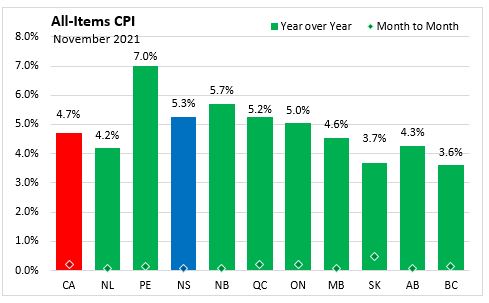
Nova Scotia’s consumer price inflation (year-over-year) excluding food and energy increased 2.7% in November 2021. Consumer prices excluding food and energy were up in all provinces led by Quebec (+3.7%). Newfoundland and Labrador had the smallest increase at 1.3%.
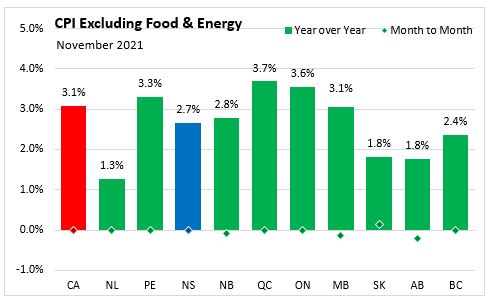
The CPI for food in Nova Scotia increased 4.2% year-over-year in November 2021. Nationally, food prices were up 4.4% from a year earlier. All provinces recorded year-over-year increase in food prices led by New Brunswick (+5.7%). Manitoba had the lowest increase at 2.5%.
Compared to the previous month, food prices in Nova Scotia were up 0.4%, below the national average of 0.9%. All provinces recorded month-over-month gains in food prices in November.
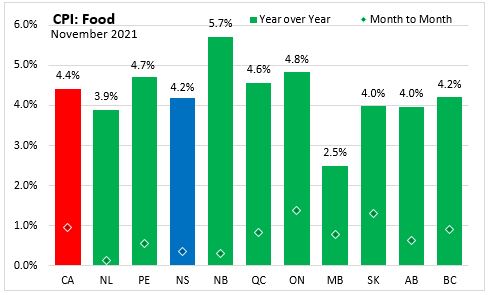
Year-over-year, shelter costs in Nova Scotia increased 6.6% in November 2021, above the national average increase of 4.8%. Compared to November 2020, shelter prices were up in all provinces with the largest increase in Prince Edward Island (+12.2%) and the smallest increase in Saskatchewan (+1.4%).
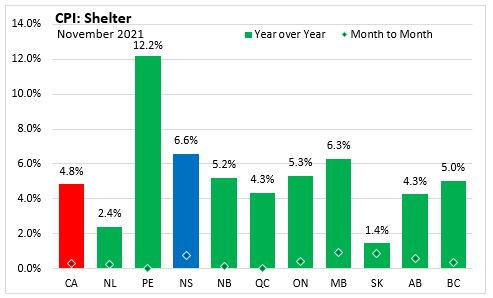
Nova Scotia energy prices increased 32.1% year-over-year in November 2021 compared to the national average of 26.4%. All provinces reported increases in energy prices of more than 20%. The year-over-year change in Nova Scotia’s and other Atlantic provinces' energy CPI is more exposed to the effects of changes in oil prices on inflation due to a larger use of fuel as a source of home heating compared to other provinces.
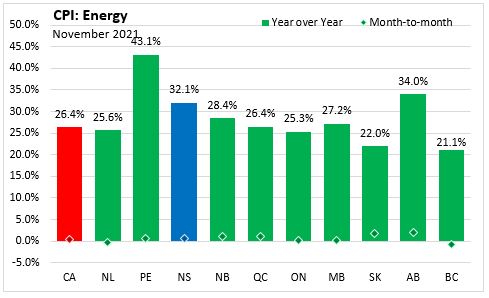
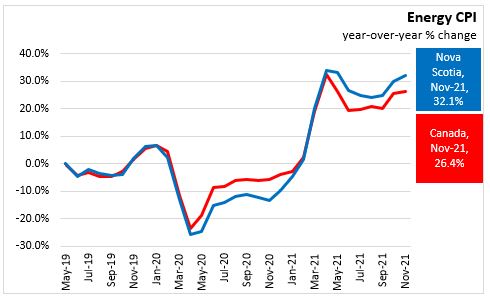
Nova Scotia's consumer price inflation (year-over-year growth in CPI) excluding energy was 2.9% in November compared to a national rate of 3.3%. Quebec (+3.9%) posted the largest year-over-year gain in while Newfoundland and Labrador (+1.7%) had the smallest change in the CPI excluding energy.

Major Components for November 2021
The following table shows the price increases specific to Nova Scotia for the major components of the CPI this month:
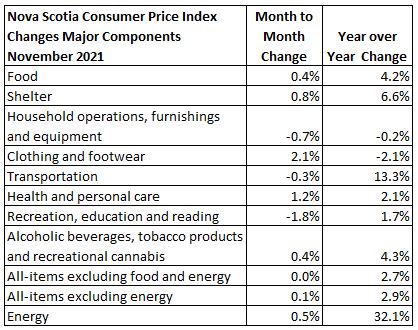
The main contributors to the monthly change (November 2021 vs October 2021) in Nova Scotia CPI were:
- Fuel oil and other fuels (+4.6%)
- Rent (+1.6%)
- Fresh vegetables (+9.0%)
- Telephone services (-5.7%)
- Travel tours (negative contribution, percent change not available)
- Non-electric kitchen utensils, tableware and cookware (-19.3%)
The main contributors to the yearly change (November 2021 vs November 2020) in Nova Scotia CPI were:
- Gasoline (+54.2%)
- Fuel oil and other fuels (+47.3%)
- Purchase and leasing of passenger vehicles (+6.1%)
- Telephone services (-15.9%)
- Mortgage interest cost (negative contribution, percent change not available)
- Women's clothing (-7.1%)
Long Run Trends
In November 2021, the all-items CPI year-over-year inflation rate for Nova Scotia was 5.3%, above Canada's rate at 4.7%. Month-to-month movements in the indices can be different, but over time they generally follow the same overall trend. Nova Scotia’s all-items CPI increase of 5.4% in October 2021 was the largest increase since March 2003 (+6.9%).
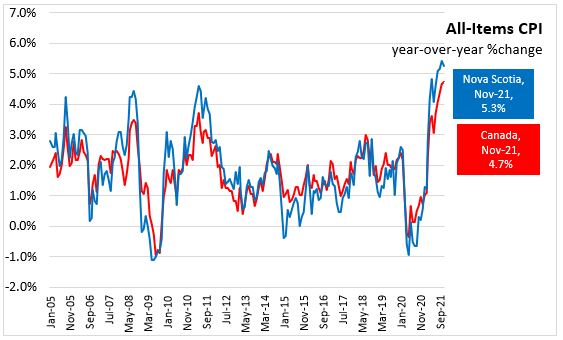
Nova Scotia’s CPI excluding food and energy increased 2.7%, decreasing 0.2 percentage point from the 2.9% increase the previous month. Canada CPI excluding food and energy declined 0.1 percentage points from 3.2% to 3.1%. The NS CPI excluding food and energy was previously above 3% in 2003.
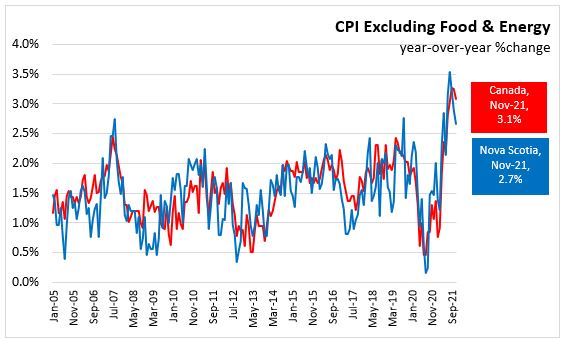
Bank of Canada's preferred measures of core inflation
Compared to November 2020, CPI-Common increased 2.0%, CPI-Median increased 2.8% and CPI-Trim was up 3.4% in Canada. All-items CPI excluding eight of the most volatile components as defined by the Bank of Canada and excluding the effect of changes in indirect taxes (formerly referred to as CPIX), rose 3.6% year-over-year. The change in the core inflation measures was up 0.2 percentage points for CPI-common, down 0.1 percentage points for CPI-median and up 0.1 percentage points for CPI-trim from the previous 12-month period.
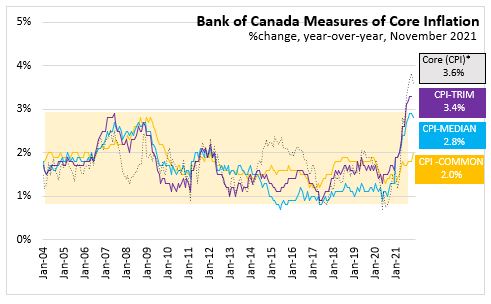
Appendix Tables and Charts
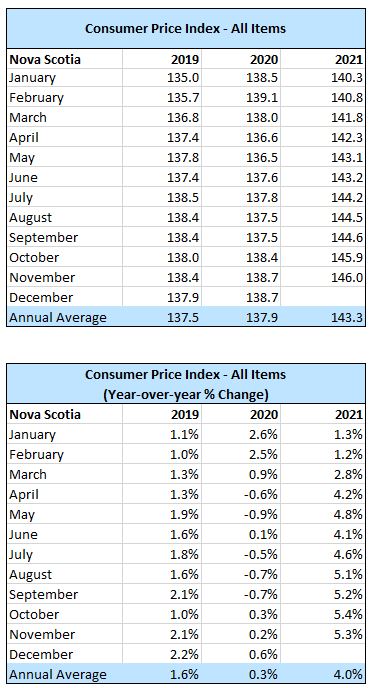

Basket Update
With the June 2020 release the CPI basket of goods and services has been updated. The new basket weights are based on 2020 expenditure data, in which spending would reflect pre-pandemic patterns (Jan-Feb), an economy mostly in lockdown (March-June), and the emergence of new consumption patterns as economy re-opened (July-December). Statistics Canada notes that the "The data reflect shifts in spending due to the COVID-19 pandemic that will likely take some time to stabilize across goods and services, and geographic regions" and the June 2021 headline CPI for Canada would be the same if the previous basket weights (2017) were used. The weights for shelter (+2.86 percentage points), households operations, furnishings and equipment (+2.23 percentage points), and alcoholic beverages, tobacco products and recreational cannabis (+1.7 percentage points) are higher in the 2020 basket while transportation had the largest decline falling from a 19.72% share to 15.34% share. New products classes were added for shipping fees and local delivery fees (including restaurant and grocery delivery fees), digital subscriptions services to magazines, and video game consoles. Further information on the update can be found in An Analysis of the 2021 Consumer Price Index Basket Update, Based on 2020 Expenditures
Source: Statistics Canada. Table 18-10-0004-01 Consumer Price Index, monthly, not seasonally adjusted; Table 18-10-0256-01 Consumer Price Index (CPI) statistics, measures of core inflation and other related statistics - Bank of Canada definitions
<--- Return to Archive